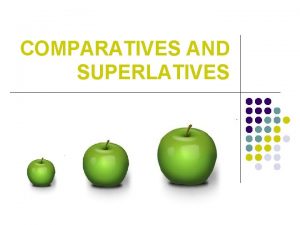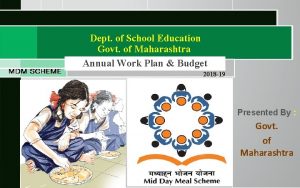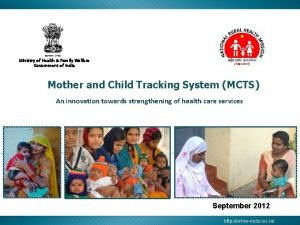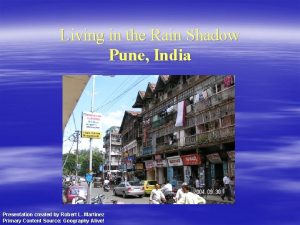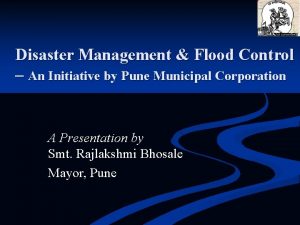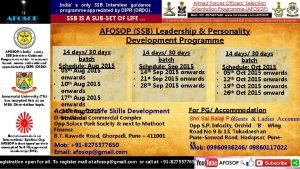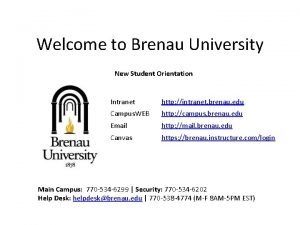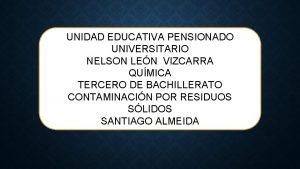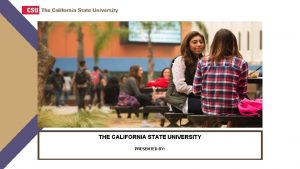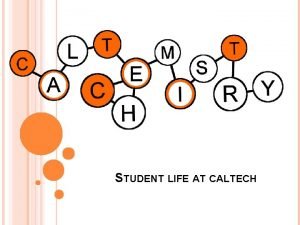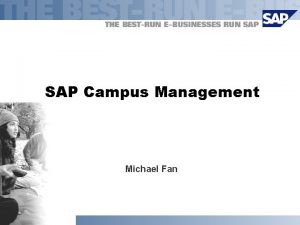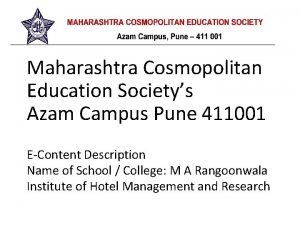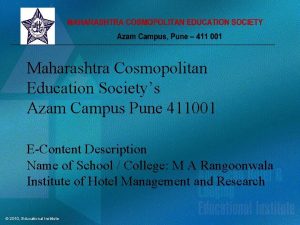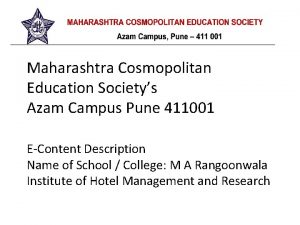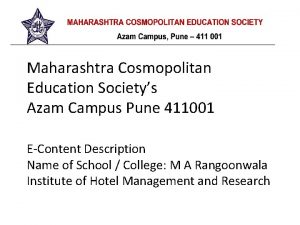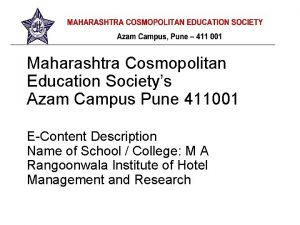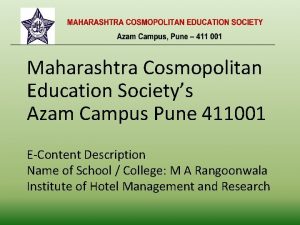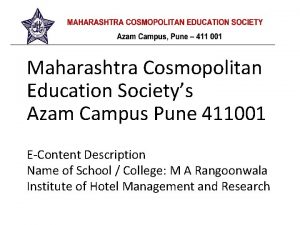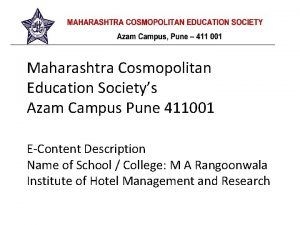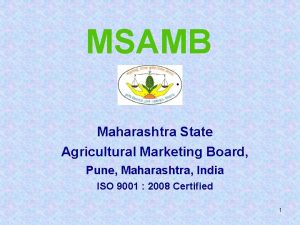Maharashtra Cosmopolitan Education Societys Azam Campus Pune 411001



































































- Slides: 67

Maharashtra Cosmopolitan Education Society’s Azam Campus Pune 411001 E-Content Description Name of School / College: M A Rangoonwala Institute of Hotel Management and Research M A Rangoonwala IHMRP © 2006, Pearson Education, Upper Saddle River, NJ 07458. All Rights Reserved.

Name and Designation of content creator /Producer Title of E content Theory/practical Title and No of Module Title and code of Paper Broad Subject Course Class Semester University /Board Date of Content Creation Name of Reviewer HOD/Principal M A Rangoonwala IHMRP Assoc. Prof Imran Sayyed Asian Cuisines Theory Asian Cuisines Principles of International Cuisine 401 Food Production BSc. HS TY Sixth SPPU 25 Jan 2020 Imran Sayyed © 2006, Pearson Education, Upper Saddle River, NJ 07458. All Rights Reserved.

Maharashtra Cosmopolitan Education Society’s Azam Campus Pune 411001 E-Content Description Name of School / College: M A Rangoonwala Institute of Hotel Management and Research M A Rangoonwala IHMRP © 2006, Pearson Education, Upper Saddle River, NJ 07458. All Rights Reserved.

Name and Designation of content creator /Producer Title of E content Theory/practical Title and No of Module Title and code of Paper Broad Subject Course Class Semester University /Board Date of Content Creation Name of Reviewer HOD/Principal M A Rangoonwala IHMRP Assoc. Prof Imran Sayyed International Cuisines Theory International Cuisines Principles of International Cuisine 401 Food Production BSc. HS TY Sixth SPPU 22 Jan 2020 Imran Sayyed © 2006, Pearson Education, Upper Saddle River, NJ 07458. All Rights Reserved.

Asian Cuisine Mostly referred to as Chinese cuisine in the past, this world-class cuisine includes Southeast Asia, the Philippines, India, and Japan M A Rangoonwala IHMRP © 2006, Pearson Education, Upper Saddle River, NJ 07458. All Rights Reserved.

M A Rangoonwala IHMRP © 2006, Pearson Education, Upper Saddle River, NJ 07458. All Rights Reserved.

Asian Cuisine • More than just a stir fry, or a curry • Can be described as a balance of flavors • Influenced by a shortage of fuel, grazing land, even food and cooking utensils • There is a staggering array of foodstuffs available • Chinese cuisine was world-class 3, 000 years ago, rivaling even ancient Rome and Egypt M A Rangoonwala IHMRP © 2006, Pearson Education, Upper Saddle River, NJ 07458. All Rights Reserved.

Influences • Chinese cuisine has influenced most of the Asian cuisines, techniques, tools, cutting procedures, heat applications • Introduced chopsticks • Religion has a major influence • Restrictions of certain meats, or any meats at all, some types of fish • Restrictions on certain days, even months M A Rangoonwala IHMRP • Geographic influences include a vast coastline, monumental distances between pockets of people in the deserts and plains of China • Colonization by Western Europeans • Warring peoples • Nomadic lifestyles • The monsoons and other climactic conditions © 2006, Pearson Education, Upper Saddle River, NJ 07458. All Rights Reserved.

Culinary Groups and Regions • China, third largest country in the world, cuisines include: – Cantonese, offering dumplings, seafood, rich sauces, minimal seasoning – Szechwan, smoked, hot/spicy, uses chiles, mustard, ginger – Beijing, known for noodles, pancakes, rolls, meatfilled buns, root vegetables, and fish and lamb; described as light, elegant, and mildly seasoned M A Rangoonwala IHMRP © 2006, Pearson Education, Upper Saddle River, NJ 07458. All Rights Reserved.

Culinary Groups and Regions (continued) • Fujian, wet dishes, cooking slowly in a broth, known for red grain, which is a sticky, glutinous fermented rice; dominant flavors are salty, sweet, and hot • Hunan, noted for presentations, foods kept distinct and separate, noted for hot, spicy, and sour; game, fish, turtle M A Rangoonwala IHMRP © 2006, Pearson Education, Upper Saddle River, NJ 07458. All Rights Reserved.

Japan • Noted for presentation • Sushi, surimi, tempura very popular in U. S. today • Also known for dried fish, pickles • Tofu, rice, and eggs and the famous green tea found to be excellent for minimizing heart disease • A variety of seafood, vegetables, and little meat • Teriyaki, wasabi, miso, fermented bean paste • Tuna and the famous dashi M A Rangoonwala IHMRP © 2006, Pearson Education, Upper Saddle River, NJ 07458. All Rights Reserved.

Southeast Asia • Subtropical, rich in seafood, fruits • Areas include Vietnam, known for fish sauce (nuoc mam), shrimp paste, lemon grass, mint, basil, and baguettes, pastries, and custards • These last products were influenced by the French colonization of the country before the 1970 s M A Rangoonwala IHMRP © 2006, Pearson Education, Upper Saddle River, NJ 07458. All Rights Reserved.

Thailand • Most notable feature of cuisine is curry flavor • Color of curry indicates the flavor profile • Green is the hottest, followed by red, and yellow curry gets its flavor from turmeric • Mussaman (Muslim) curry includes Middle Eastern spice influences • Other important flavor ingredients include kaffir lime leaves, lemongrass, holy basil, tamarind, galangal, sambal olek M A Rangoonwala IHMRP © 2006, Pearson Education, Upper Saddle River, NJ 07458. All Rights Reserved.

Other Areas of Culinary Notability • Korea is influenced by China and Japan – Seafood, pickled vegetables and cabbage (kimchee), hearty stews, and a dish known as bulgogi • Malaysia and the Philippines – Meats, seafood (pork) and poultry is easily grown or harvested – The Philippines are also influence by a long colonization by Spain, and by the commerce and migration from the mainland areas M A Rangoonwala IHMRP © 2006, Pearson Education, Upper Saddle River, NJ 07458. All Rights Reserved.

Staple Foods of Asia • • Grain, throughout most areas Legumes, noodles, millet, and buckwheat Beans, nuts, seeds, lentils very popular Vegetables include bamboo shoots, water chestnuts, okra from Africa, hearts of palm, mushrooms • Fruits include cherries, plums, peaches, pomegranates, figs, citrus, apples, carambolas, and bananas M A Rangoonwala IHMRP © 2006, Pearson Education, Upper Saddle River, NJ 07458. All Rights Reserved.

Meats, Poultry, and Fish • Northern countries rely on lamb and sheep • Fresh- and saltwater fish are available to most countries • Chickens and ducks are everywhere • Pork is available throughout, while beef is available in the big grazing plains M A Rangoonwala IHMRP © 2006, Pearson Education, Upper Saddle River, NJ 07458. All Rights Reserved.

Common Flavors • Every region and country has a distinct flavor profile • Some very hot, some subtle and some mild • Flavor profiles come from various combinations: of cilantro, mint, basil, lemongrass, fermented sauces and pastes such as bean paste, soy sauce, rice wine and vinegar, pickled ginger, fish sauce (nouc man), Hoisan and plum sauce M A Rangoonwala IHMRP © 2006, Pearson Education, Upper Saddle River, NJ 07458. All Rights Reserved.

Cooking Methods • Stir-frying, cutting foods to shorten cooking times, and use little oil and heat • Steaming, used to prepare dumplings, steamed fish in bamboo baskets, steam bread • Deep-frying, tempura in Japan uses rice flour, peanut oil in other areas M A Rangoonwala IHMRP • Simmering and braising • Salads used to cool the heat in other dishes • Grilling, often over open fires or braisiers • Nomadic people pick up dried dung for fuel © 2006, Pearson Education, Upper Saddle River, NJ 07458. All Rights Reserved.

Middle Eastern Countries • Egypt, Lebanon, Greece, and Morocco M A Rangoonwala IHMRP © 2006, Pearson Education, Upper Saddle River, NJ 07458. All Rights Reserved.

• GEOGRAPHIC SETTING AND ENVIRONMENT • Morocco is located in the northwestern corner of Africa. Morocco is slightly larger in area than California, and its territory has three different regions. The northern coast along the Mediterranean Sea is made up of fertile land that rises to elevations of about 8, 000 feet (2, 400 meters). The Atlas Mountains run between the Atlantic coast in the southwest to the Mediterranean Sea in the northeast. Finally, the semiarid area in the south and east known as the Western Sahara connects Morocco with the vast African Sahara Desert M A Rangoonwala IHMRP © 2006, Pearson Education, Upper Saddle River, NJ 07458. All Rights Reserved.

• HISTORY AND FOOD • Nomads called Berbers were the first inhabitants of Morocco over two thousand years ago. They used local ingredients, such as olives, figs, and dates, to prepare lamb and poultry stews. Over time, traders and conquering nations introduced new food customs. Among them were the Phoenicians, Carthaginians, and Romans. However, the strongest influence on native cooking was the Arab invasion in the seventh century A. D. M A Rangoonwala IHMRP © 2006, Pearson Education, Upper Saddle River, NJ 07458. All Rights Reserved.

• FOODS OF THE MOROCCANS • Morocco, unlike most other African countries, produces all the food it needs to feed its people. Its many homegrown fruits and vegetables include oranges, melons, tomatoes, sweet and hot peppers, and potatoes. Five more native products that are especially important in Moroccan cooking are lemons, olives, figs, dates, and almonds. Located on the coast of the Mediterranean Sea, the country is rich in fish and seafood. Beef is not plentiful, so meals are usually built around lamb or poultry. M A Rangoonwala IHMRP © 2006, Pearson Education, Upper Saddle River, NJ 07458. All Rights Reserved.

• MEALTIME CUSTOMS • Moroccans eat their meals at low round tables, sitting on cushions on the floor. They eat with their hands instead of silverware, using the thumb and first two fingers of their right hands. They also use pieces of bread to soak up sauces and carry food to the mouth. Small warmed, damp towels are passed around before the meal to make sure everyone's hands are clean. Most meals consist of a single main dish, often a stew, a cous dish, or a hearty soup. It is served with bread, salad, cold vegetables, and cous or rice on the side. A typical breakfast might include beyssara (dried fava beans stewed with cumin and paprika), beghrir (pancakes), and bread. Two breakfast favorites that may sound exotic to Westerners are lambs' heads and calves' feet. M A Rangoonwala IHMRP © 2006, Pearson Education, Upper Saddle River, NJ 07458. All Rights Reserved.

Egypt Cuisine • GEOGRAPHIC SETTING AND ENVIRONMENT • The Arab Republic of Egypt is located in the northeastern region of the African continent, bordering both the Mediterranean and Red Seas. The climate is arid and dry and most of the country receives less than one inch of rainfall each year. The Mediterranean may offer Egypt's northern coastline up to eight inches of rainfall each year, and keeps year-round temperatures cooler than the inland deserts. The widespread lack of rainfall makes it extremely difficult to grow crops. Egypt has no forests and only 2 percent of the land is arable (land that can be farmed). M A Rangoonwala IHMRP © 2006, Pearson Education, Upper Saddle River, NJ 07458. All Rights Reserved.

• HISTORY AND FOOD • Thousands of years ago, ancient Egyptians left evidence of their love for food. Well-preserved wall paintings and carvings have been discovered on tombs and temples, depicting large feasts and a variety of foods. Many of these ancient foods are still eaten in Egyptian households today. Peas, beans, cucumbers, dates, figs, and grapes were popular fruits and vegetables in ancient times. Wheat and barley, ancient staple crops, were used to make bread and beer. Fish and poultry were also popular. • Dried Egypt fish was prepared by cleaning the fish, coating the pieces with salt, and placing them the sun to dry. Fasieekh (salted, dried fish) remained a popular meal in Egypt as of 2000 M A Rangoonwala IHMRP © 2006, Pearson Education, Upper Saddle River, NJ 07458. All Rights Reserved.

• FOODS OF THE EGYPTIANS • Egypt has a variety of national dishes. Ful (pronounced "fool, " bean paste), tahini (sesame paste), koushari (lentils, macaroni, rice, and chickpeas), aish baladi (a pita-like bread), kofta (spicy, minced lamb), and kebab (grilled lamb pieces) are the most popular. M A Rangoonwala IHMRP © 2006, Pearson Education, Upper Saddle River, NJ 07458. All Rights Reserved.

• FOOD FOR RELIGIOUS AND HOLIDAY CELEBRATIONS • Approximately 90 percent of Egyptians are Muslims, which means they practice the religion of Islam. The most important time of the year for Muslims is a monthlong holiday called Ramadan. During the month of Ramadan (the ninth month on the Islamic calendar, usually November or December), Muslims fast (do not eat or drink) from sunrise to sunset, and think about people around the world who do not have enough food. Muslim families will often come together to prepare hearty meals, including a variety of sweets, after sunset. Muslims end Ramadan with a three-day celebration © 2006, Pearson Education, Upper Saddle River, NJ 07458. M A Rangoonwala IHMRP All Rights Reserved. called Eid al-Fitr.

• MEALTIME CUSTOMS • Dining customs vary throughout the country and between different religions. When guests are in the presence of Muslims (who make up approximately 90 percent of Egypt's population), there are some general guidelines one should follow. The left hand is considered unclean and should not be used for eating, feet should always been tucked under the table, and alcohol and pork should not be requested. M A Rangoonwala IHMRP © 2006, Pearson Education, Upper Saddle River, NJ 07458. All Rights Reserved.

Lebanese Cuisine • GEOGRAPHIC SETTING AND ENVIRONMENT • Situated on the eastern coast of the Mediterranean Sea, Lebanon has an area of 4, 015 square miles (10, 400 square kilometers), about three-fourths the size of the state of Connecticut. The Lebanon Mountains are rugged. East of the Lebanon Mountains is the Bekaa Valley, an extremely fertile flatland. At the eastern flank of the Bekaa stands Mount Hermon, straddling the border with Syria. Lebanon contains few rivers, and its harbors are mostly shallow and small, with polluted coastal waters. Lebanon has an extraordinarily varied climate: within a 45 -minutes drive in winter, spring, and fall, both skiing and swimming are possible. Less than 30% of Lebanon's total area can support crop production. Expansion of cultivated areas is limited by the arid and rugged nature of the land. M A Rangoonwala IHMRP © 2006, Pearson Education, Upper Saddle River, NJ 07458. All Rights Reserved.

• HISTORY AND FOOD • A unique cultural history has helped to make Lebanese food the most popular of all Middle Eastern cuisines. For most of its past, Lebanon has been ruled by foreign powers that have influenced the types of food the Lebanese ate. From 1516 to 1918, the Ottoman Turks controlled Lebanon and introduced a variety of foods that have become staples in the Lebanese diet, including olive oil, fresh bread, baklava (a sweet pastry dessert), laban (homemade yogurt), stuffed vegetables, and a variety of nuts. The Ottomans also increased the popularity of lam M A Rangoonwala IHMRP © 2006, Pearson Education, Upper Saddle River, NJ 07458. All Rights Reserved.

• FOODS OF THE LEBANESE • The Lebanese diet focuses on herbs, spices, and fresh ingredients (the Lebanese rarely eat leftovers), relying less on heavy sauces. Mint, parsley, oregano, garlic, allspice, nutmeg, and cinnamon are the most common seasonings. • Bread, a staple food in Lebanon, is served with almost every meal, most often as a flat bread, or pita. It is so crucial to the Lebanese diet that some Arabic dialects refer to it as esh , meaning "life. " M A Rangoonwala IHMRP © 2006, Pearson Education, Upper Saddle River, NJ 07458. All Rights Reserved.

• Fruit, vegetables, rice, and bread out-weigh the amount of meat eaten in the average Lebanese meal. However, the most commonly eaten meats, poultry and lamb, make up some of the country's most popular dishes. The national dish, kibbeh (or kibbe ), consists of a ground lamb and cracked wheat paste, similar to paté. Kibbeh was originally made by harshly pounding the lamb and kneading in the spices and wheat. Those who were unfamiliar with this practice often found it quite unpleasant, including the English food writer George Lassalle, who described it as "frightening. " Some rural villages continue to prepare it this way. M A Rangoonwala IHMRP © 2006, Pearson Education, Upper Saddle River, NJ 07458. All Rights Reserved.

• FOOD FOR RELIGIOUS AND HOLIDAY CELEBRATIONS • It seems as though the Lebanese are always participating in holiday celebrations, especially religious holy days. This is because Lebanon is home to two main religions: Islam and Christianity. Despite bitter disagreements between them, the people of both religions continue to enjoy their own traditional festive celebrations, which often include large feasts among family and friends. M A Rangoonwala IHMRP © 2006, Pearson Education, Upper Saddle River, NJ 07458. All Rights Reserved.

• Muslims (believers of Islam) celebrate several holidays throughout the year, though probably none are as important as the holiday of Ramadan. During the entire ninth month of the Islamic calendar, Muslims avoid all food and drink between sunrise and sunset. In some villages, a man beats a drum through the streets, attempting to wake people before the sun rises so that they may enjoy an early breakfast. A typical pre-dawn breakfast might include grapefruit, pita bread with olive oil, a boiled egg, a cup of laban (yogurt), and tea. After the sun sets, Muslims gather with friends and family to share in a delicious feast. M A Rangoonwala IHMRP © 2006, Pearson Education, Upper Saddle River, NJ 07458. All Rights Reserved.

• MEALTIME CUSTOMS • Arabs have a reputation for hospitality towards guests that come to visit, even if the visit was not planned (which most are not). Food is almost guaranteed to be delicious and filling. • A rural family will often pick fruit and vegetables from their own gardens. If they do not have what they need, a souk (street market shop) can provide them with any food from eggplant to mint leaves. Because bread is essential with almost every meal, rural women travel to the village bakery, called the foorn , to bake their breads and pastries for the day, as well© 2006, as Pearson to catch up on. Saddle gossip. Education, Upper River, NJ 07458. M A Rangoonwala IHMRP All Rights Reserved.

• Lunch, the largest of the three meals eaten each day, is usually served around 2: 00 p. m. Mezze , several appetizer-like dishes, are served first. Warm bread, hummus (chickpea paste), and olives, cheese, and pistachio nuts are commonly served. Kibbeh , the national dish, is frequently the main meal. Kebabs (cubes of cooked meat on a skewer) and kefta (ground meat mixed with herbs and spices) are popular too. Baklava or a fresh bowl of melon will likely make for a sweet dessert. Most children nap after such a plentiful afternoon meal M A Rangoonwala IHMRP © 2006, Pearson Education, Upper Saddle River, NJ 07458. All Rights Reserved.

Greek Cuisine • GEOGRAPHIC SETTING AND ENVIRONMENT • Greece is the southernmost country in the Balkan Peninsula, the region that includes Albania, Macedonia, and Bulgaria to the north. It has a total area of 131, 940 square kilometers (50, 942 square miles). About a fifth of the area is composed of more than 1, 400 islands in the Ionian and Aegean seas. About four-fifths of Greece is mountainous, including most of the islands M A Rangoonwala IHMRP © 2006, Pearson Education, Upper Saddle River, NJ 07458. All Rights Reserved.

• The Greek diet has been influenced by traditions from both the East and West. In ancient times, the Persians introduced Middle Eastern foods, such as yogurt, rice, and sweets made from nuts, honey, and sesame seeds. In 197 B. C. , when Rome invaded Greece, the Romans brought with them foods that are typical in Italy today including pasta and sauces. Arab influences have left their mark in the southern part of Greece. Spices such as cumin, cinnamon, allspice, and cloves play a prominent role in the diet of these regions. The Turks later M A Rangoonwala IHMRP © 2006, Pearson Education, Upper Saddle River, NJ 07458. All Rights Reserved.

• FOODS OF THE GREEKS • Fresh fruits and vegetables play a large role in the Greek diet. With its long coastline, Greece also relies heavily on fish and seafood. Meat tends to play a less important role. It is often used as an ingredient in vegetable dishes instead of as a main dish. The islands and coastal areas of Greece favor lighter dishes that feature vegetables or seafood. In contrast, the inland regions use more meat and cheese in their cooking. M A Rangoonwala IHMRP © 2006, Pearson Education, Upper Saddle River, NJ 07458. All Rights Reserved.

France • GEOGRAPHIC SETTING AND ENVIRONMENT • France is the second-largest country in Europe (after Russia). Much of the country is surrounded by mountains. The highest mountain, Mount Blanc, is near France's border with Italy. The climate and soil of France create good conditions for farming. Although only four percent of the French people earn their living from farming, the country is self-sufficient when it comes to growing its own food. M A Rangoonwala IHMRP © 2006, Pearson Education, Upper Saddle River, NJ 07458. All Rights Reserved.

• HISTORY AND FOOD • The French have always been proud of their sophisticated way of cooking. Fertile soil provides fresh fruits, vegetables, herbs, grains, and meat, nearly yearround. The soil is also suitable for growing grapes, which are used for making some of the finest wines in the world. Food and alcohol play important roles in French society —the way a person eats often reflects their French heritage, region of birth, social status, and health. M A Rangoonwala IHMRP © 2006, Pearson Education, Upper Saddle River, NJ 07458. All Rights Reserved.

• FOODS OF THE FRENCH • The baguette, a long, thin loaf of crusty bread, is the most important part of any French meal. Everyone at the table is expected to eat a piece. It is eaten in a variety of ways, including being used to make • France sandwiches. Melted cheese spread on a baguette is often presented as part of a meal. A meal of grilled food (called la raclette ) is sometimes served. Using an open grill, diners melt their own cheese with ham or beef slices, or fry their own egg. The grilled food is accompanied by potatoes. Sometimes diners spear pieces of bread on long-handled forks, and dip the bread into a pot full of melted cheese©called la fondue. 2006, Pearson Education, Upper Saddle River, NJ 07458. M A Rangoonwala IHMRP All Rights Reserved.

• FOOD FOR RELIGIOUS AND HOLIDAY CELEBRATIONS • Major French holidays include Christmas (December 25), New Year's Day (January 1), and Bastille Day (July 14). On Bastille Day, named for the prison that citizens stormed on July 14, 1789, the French celebrate their liberation (freedom) from the monarchy and the beginning of their Republic. There are fireworks, dances, and parties with picnics. Picnics almost always include fromage (cheese), such as Camembert, brie, chevre (goat's milk cheese), or Roquefort M A Rangoonwala IHMRP © 2006, Pearson Education, Upper Saddle River, NJ 07458. All Rights Reserved.

• MEALTIME CUSTOMS • When entertaining at home, the hosts pride themselves on making mealtime a memorable and positive experience. For everyday lunches and dinners, four courses are typically served: salad, main dish with meat, cheese with bread, and dessert. Bread and water are always served. Special occasions include even more courses such as an appetizer of savory pastries, or other finger foods. This is normally served with an alcoholic beverage, often French wine. Several bottles of wine may be served with the meal. Coffee is also served. M A Rangoonwala IHMRP © 2006, Pearson Education, Upper Saddle River, NJ 07458. All Rights Reserved.

• GEOGRAPHIC SETTING AND ENVIRONMENT • Located in southern Europe, Italy is slightly larger than the state of Arizona. Most of Italy is mountainous, and it is home to Mount Vesuvius, the only active volcano on the European mainland. • A fertile valley surrounds the Po River, the largest river in Italy. Many different plants thrive in its rich soil. Italy is surrounded by water on three sides and benefits from a variety of seafood and coastal vegetation. • Climate varies depending on elevation and region. Colder temperatures can be found in the mountainous regions, particularly within the high peaks of the Alps, a mountain range in the northwest. Temperatures are warmer in the Po River valley, the coastal lowlands, and on Italy's islands (Sicily and Sardinia), with an average annual temperature around 60°F. M A Rangoonwala IHMRP © 2006, Pearson Education, Upper Saddle River, NJ 07458. All Rights Reserved.

• Italy changed in many ways when the economy flourished following World War II (1939– 45). During this time, farming was modernized and new technologies and farming systems were introduced. Various culinary practices throughout the country's regions began to be combined after people started migrating from the countryside to the cities. Many southern Italians traveled to the north at this time, introducing pizza to northern Italians. Those from the north introduced risotto (a rice dish) and polenta (a simple, cornmeal dish) to the south. Fast foods, mostly introduced from the United States, have brought more culinary diversity to Italy. However, pride in the culture of one's region, or companilismo, extends to the food of the locality, and regional cooking styles are celebrated throughout the country. M A Rangoonwala IHMRP © 2006, Pearson Education, Upper Saddle River, NJ 07458. All Rights Reserved.

• FOODS OF THE ITALIANS • Although Italians are known throughout the world for pizza, pasta, and tomato sauce, the national diet of Italy has traditionally differed greatly by region. Prior to the blending of cooking practices among different regions, it was possible to distinguish Italian cooking simply by the type of cooking fat used: butter was used in the north, pork fat in the center of the country, and olive oil in the south. Staple dishes in the north were rice and polenta, and pasta was most popular throughout the south. During the last decades of the twentieth century (1980 s and 1990 s), however, pasta and pizza (another traditional southern food) became popular in the north of Italy. Pasta is more likely to be served with a white cheese sauce in the north and a tomato-based sauce in the south. M A Rangoonwala IHMRP © 2006, Pearson Education, Upper Saddle River, NJ 07458. All Rights Reserved.

• MEALTIME CUSTOMS • Italians generally eat three meals a day. Adults eat a light breakfast ( la prima colazione ), often stopping at a coffee shop on their way to work for a caffellatte (coffee with milk) or cappuccino with bread, butter, and jam, or cake. Lunch and dinner are similar meals. They consist of an antipasto (an appetizer based on cold meats), a pasta or rice dish (depending on the region) such as risotto, a main meat or fish course, a salad, and cheese and fruit. Lunch ( il pranza or la seconda colazione ) is the main meal of the day for many Italians and is eaten between noon and 2 P. M. M A Rangoonwala IHMRP © 2006, Pearson Education, Upper Saddle River, NJ 07458. All Rights Reserved.

• GEOGRAPHIC SETTING AND ENVIRONMENT • With Portugal, Spain makes up the Iberian Peninsula, or Iberia is separated from the rest of Europe by the Pyrenees Mountains, which rise to a height of 11, 168 feet (3, 404 meters). The peninsula is bordered by the waters of the Mediterranean Sea on the east, the Strait of Gibraltar on the south, the Atlantic Ocean on the west, and the Bay of Biscay on the northwest. Spain's miles of coastline (more than any other European country) provide it with bountiful seafood and fish. Spain is also a close neighbor to Africa. Morocco lies only a short distance—eight miles (thirteen kilometers) —across the Strait of Gibraltar from the southern tip of Spain. M A Rangoonwala IHMRP © 2006, Pearson Education, Upper Saddle River, NJ 07458. All Rights Reserved.

• HISTORY AND FOOD • As a gateway between Europe and Africa, and the Mediterranean Sea and the Atlantic Ocean, Spain has been much fought over throughout history. The Greeks settled its coastal areas as early as the eighth century B. C. , while Celts occupied interior regions. By the second century B. C. , Spain was under Roman domination. In the early eighth century A. D. , the Moors (Arabs from northern Africa) crossed Gibraltar and entered Spain, occupying it for the next 700 years before Christian kingdoms drove them out. M A Rangoonwala IHMRP © 2006, Pearson Education, Upper Saddle River, NJ 07458. All Rights Reserved.

• FOODS OF THE SPANIARDS • Spain's culinary traditions rely on an abundance of locally grown vegetables and fruits as well as meats and poultry. Jamón serrano , a cured ham, and chorizo , a seasoned sausage, are popular. Seafood and fish are popular in coastal areas. Other popular foods are cheeses, eggs, beans, rice, nuts (especially almonds), and bread (a crusty white bread, baked fresh daily, is common). Olive oil and garlic are common ingredients. Spain is also known for its wines, including the rioja , made in the northern province; sherry, a fortified wine that may be dry or sweet; and sangria, wine mixed with fruit and soda water. M A Rangoonwala IHMRP © 2006, Pearson Education, Upper Saddle River, NJ 07458. All Rights Reserved.

• FOOD FOR RELIGIOUS AND HOLIDAY CELEBRATIONS • To bring good luck in the year ahead, Spaniards traditionally eat twelve grapes, one with each chime of the clock at midnight on New Year's Eve. On February 3, St. Blaise's Day ( Día de San Blas ) is celebrated by baking small loaves of bread, called panecillos del santo, which are blessed at Mass in the Roman Catholic church. According to tradition, all the children in the household are to eat a bit of this bread to protect them from choking in the year ahead M A Rangoonwala IHMRP © 2006, Pearson Education, Upper Saddle River, NJ 07458. All Rights Reserved.

• MEALTIME CUSTOMS • Daily meals in Spain begin with a light breakfast ( desayuno ) at about 8 a. m. Next comes a three-course lunch (comida ), the main meal of the day. Families gather to eat it in the mid-afternoon (about 2 p. m. ). At about 10 p. m. supper ( cena ), a lighter meal, is served. In addition, bollos (small rolls) may be eaten in the late morning; the merienda , a snack of tea or Chocolate a la España (Spanish-style hot chocolate) and pastries may be enjoyed in the early evening (about 5 p. m. ); and tapas , traditional Spanish appetizers, are consumed around 8 p. m. , before supper. M A Rangoonwala IHMRP © 2006, Pearson Education, Upper Saddle River, NJ 07458. All Rights Reserved.

M A Rangoonwala IHMRP © 2006, Pearson Education, Upper Saddle River, NJ 07458. All Rights Reserved.

Latin Cuisine • GEOGRAPHIC SETTING AND ENVIRONMENT • Although Latino Americans, also known as Hispanic Americans, live throughout the United States, the states with the largest populations are California, Arizona, New Mexico, Florida, and New York. Latinos may be of any race, and may trace their family history to any of the countries where Spanish is the principal language (except Spain), particularly those in Latin America. The masculine form of the word is Latino, and the feminine form is Latina M A Rangoonwala IHMRP © 2006, Pearson Education, Upper Saddle River, NJ 07458. All Rights Reserved.

Latin Cuisine • HISTORY AND FOOD • Mexican Americans have lived in the United States for most of the country's history. However, other Spanish-speaking immigrants did not begin arriving in large numbers until after World War II (1939– 1945). Many Puerto Ricans arrived in the 1950 s. Cubans, Dominicans, Colombians, and Costa Ricans immigrated in the 1960 s. And, people from still other Latin American countries followed in succeeding years. As of 2001, the three largest Latino ethnic groups were Mexican American, Puerto Rican, and Cuban American. • Like most immigrant groups, Latino Americans have remained loyal to the food traditions of their homelands. Many shop in small ethnic markets called bodegas that carry specialty foods used in Latin cooking. When they cook, they follow recipes handed down to them by their parents and grandparents. Specialty food companies have © 2006, Pearson Education, Upper Saddle River, NJ 07458. thrived by supplying M A Rangoonwala IHMRP Latinos with traditional cooking ingredients. The All Rights Reserved.

Latin Cuisine • FOODS OF THE LATINO AMERICANS • Although Latino Americans belong to a number of different cultures, their cooking styles have certain things in common. Meat, usually pork or beef, is central to the Latino diet. It is often eaten with the spicy sauces (salsas) for which Latinos are famous. The main ingredient in salsa, as well as many other Latin dishes, is hot chili peppers. Latinos cook with fresh, dried, and ground chilies. There are many different kinds of chilies, including Habanero, Jalapeno, Malagueta, and Poblano. M A Rangoonwala IHMRP © 2006, Pearson Education, Upper Saddle River, NJ 07458. All Rights Reserved.

Latin Cuisine • Corn, beans, rice, and root vegetables are staples of the Latino diet. Some of the root vegetables commonly used in Latino cooking are sweet potatoes, yams, yucca, jicama, Jerusalem artichokes, and taro. Also popular is a pear-shaped squash called chayote. It goes by several other names, including tayote, chuchu, and xuxu. Latinos are able to enjoy many fruits native to their homelands, which are either imported or cultivated in the United States. These include plantains, guavas, mangoes, papayas, passion fruit, and prickly pears. M A Rangoonwala IHMRP © 2006, Pearson Education, Upper Saddle River, NJ 07458. All Rights Reserved.

• • FOOD FOR RELIGIOUS AND HOLIDAY CELEBRATIONS The vast majority of Latinos are Roman Catholic and celebrate the holidays of the Christian calendar. • Making tamales and pasteles together is a popular family tradition around the Christmas holidays. Both consist of dough wrapped around meat or some other filling. The tamale dough is placed inside an empty cornhusk. The pastele dough is placed inside a wrapper made from banana leaves. Another Christmas favorite is menudo , a spicy stew made with hot chilies and a cow's stomach (called tripe). • A special Latino New Year's Eve tradition is to eat twelve grapes or raisins at midnight. They stand for the twelve months of the new year. Adults often welcome the new year with a drink that contains rum and tropical fruit. It is poured into a punch bowl, and a whole pineapple is put in the bowl. It is said that the people who drink this beverage will enjoy friendship throughout the coming year. On New Year's Eve, Latinos of Colombian descent enjoy a dessert called bunuelos. These are balls of dough made from flour, sugar, eggs, and butter and deep fried. M A Rangoonwala IHMRP © 2006, Pearson Education, Upper Saddle River, NJ 07458. All Rights Reserved.

Latin Cuisine • • MEALTIME CUSTOMS Most Latinos eat three meals a day. The main meal is eaten at dinnertime. Eating together with the family is important to Latinos. Many families pray together before meals. • Busy schedules sometimes keep families from eating together during the week. On Sundays, they can still gather to cook together and share food, prayer, and the latest news. Many Latino children have Sunday dinner with their aunts, uncles, grandparents, and cousins. • In the past, most Latinos ate large, home-cooked meals every day. Foods were made from traditional recipes that were hard to prepare and were time consuming. As more women have entered the work force, there is less time to cook some of these traditional foods. Also, Latinos, like other Americans, eat out more than they used to. Some even gather in restaurants for the big family dinner on Sunday. M A Rangoonwala IHMRP © 2006, Pearson Education, Upper Saddle River, NJ 07458. All Rights Reserved.

Latin Cuisine • Ingredients that are common in most islands' dishes are rice, plantains, beans, cassava, culantro, bell peppers, chickpeas, tomatoes, sweet potatoes, coconut, and any of various meats that are locally available like beef, poultry, pork or fish. A characteristic seasoning for the region is a green herb and oil based marinade which imparts a flavor profile which is quintessentially Caribbean in character. Ingredients may include garlic, onions, scotch bonnet peppers, celery, green onions, and herbs like culantro, marjoram, rosemary, tarragon and thyme. This green seasoning is used for a variety of dishes like curries, stews and roasted meats. [2] • . M A Rangoonwala IHMRP © 2006, Pearson Education, Upper Saddle River, NJ 07458. All Rights Reserved.

Latin Cuisine • Traditional dishes are so important to regional culture that, for example, the local version of Caribbean goat stew has been chosen as the official national dish of Montserrat and is also one of the signature dishes of St. Kitts and Nevis. Another popular dish in the Anglophone Caribbean is called "Cook-up", or pelau. Ackee and saltfish is another popular dish that is unique to Jamaica. Callaloo is a dish containing leafy vegetablesspinach and sometimes okra amongst others, widely distributed in the Caribbean, with a distinctively mixed African and indigenous character M A Rangoonwala IHMRP © 2006, Pearson Education, Upper Saddle River, NJ 07458. All Rights Reserved.

Mexican • • • The Mexica establishment of the Aztec Empire created a multi-ethnic society where many different foodways became infused. The staples are native foods, such as corn, beans, squash, amaranth, chia, avocados, tomatoes, tomatillos, cacao, vanilla, agave, turkey, spirulina, sweet potato, cactus, and chili pepper. After the Spanish conquest of the Aztec Empire in the 16 th century, Europeans introduced a number of other foods, the most important of which were meats from domesticated animals (beef, pork, chicken, goat, and sheep), dairy products (especially cheese and milk), and rice. While the Spanish initially tried to impose their own diet on the country, this was not possible. African and Asian influences were also introduced into the indigenous cuisine during this era as a result of African slavery in New Spain and the Manila-Acapulco Galleons. [2] M A Rangoonwala IHMRP © 2006, Pearson Education, Upper Saddle River, NJ 07458. All Rights Reserved.

Mexican • Over the centuries, this resulted in regional cuisines based on local conditions, such as those in Oaxaca, Veracruz and the Yucatán Peninsula. Mexican cuisine is an important aspect of the culture, social structure and popular traditions of Mexico. The most important example of this connection is the use of mole for special occasions and holidays, particularly in the South and Central regions of the country. For this reason and others, traditional Mexican cuisine was inscribed in 2010 on the Representative List of the Intangible Cultural Heritage of Humanity by UNESCO. [3] M A Rangoonwala IHMRP © 2006, Pearson Education, Upper Saddle River, NJ 07458. All Rights Reserved.

• • • Ingredients at a market in Mexico City, including huitlacoche, quintoniles, huauzontle and squash flowers. Mexican cuisine is as complex as other ancient cuisines, such as those of Indian Cuisine, China and Japan, with techniques and skills developed over thousands of years of history. [4] It is created mostly with ingredients native to Mexico, as well as those brought over by the Spanish conquistadors, with some new influences since then. [5] In addition to staples, such as corn and chile peppers, native ingredients include tomatoes, squashes, avocados, cocoa and vanilla, [3] as well as ingredients not generally used in other cuisines, such as edible flowers, vegetables like huauzontle and papaloquelite, or small criollo avocados, whose skin is edible. [6] Vegetables play an important role in Mexican cuisine. Common vegetables include zucchini, cauliflower, corn, potatoes, spinach, Swiss chard, mushrooms, jitomate (red tomato), green tomato, etc. Other traditional vegetable ingredients include chiles, huitlacoche (corn fungus), huauzontle, and nopal (cactus leaves) to name a few. European contributions include pork, chicken, beef, cheese, herbs and spices, as well as some fruits. Tropical fruits, many of which are indigenous to Mexico and the Americas, such as guava, prickly pear, sapote, mangoes, bananas, pineapple and cherimoya (custard apple) are popular, especially in the center and south of the country M A Rangoonwala IHMRP © 2006, Pearson Education, Upper Saddle River, NJ 07458. All Rights Reserved.

• Vegetables play an important role in Mexican cuisine. Common vegetables include zucchini, cauliflower, corn, potatoes, spinach, Swiss chard, mushrooms, jitomate (red tomato), green tomato, etc. Other traditional vegetable ingredients include chiles, huitlacoche (corn fungus), huauzontle, and nopal (cactus leaves) to name a few. • European contributions include pork, chicken, beef, cheese, herbs and spices, as well as some fruits. • Tropical fruits, many of which are indigenous to Mexico and the Americas, such as guava, prickly pear, sapote, mangoes, bananas, pineapple and cherimoya (custard apple) are popular, especially in the center and south of the countr M A Rangoonwala IHMRP © 2006, Pearson Education, Upper Saddle River, NJ 07458. All Rights Reserved.

• • • Ref: 1) Wikipedia. org 2) Ww. thespuceeats. com 3) theculinary. pro. com 4) ihmnotessite. net 5) slideshare. net 6) escoffieronline. com 7) tutorialpoint. com 8) coursehero. com 9) hmhub. net 10) hospitalitytourism. blogspot. com M A Rangoonwala IHMRP © 2006, Pearson Education, Upper Saddle River, NJ 07458. All Rights Reserved.
 Superlative patterns
Superlative patterns Cosmopolitan survey
Cosmopolitan survey Saral mdm
Saral mdm Ayat azam tahun baru
Ayat azam tahun baru Nehru report
Nehru report Quaid e azam 14 points
Quaid e azam 14 points Lorraine azam
Lorraine azam Nouman azam
Nouman azam Azam bhaloo
Azam bhaloo Pt azam laksana intan buana
Pt azam laksana intan buana Gram panchayat portal maharashtra
Gram panchayat portal maharashtra Site facebook com
Site facebook com Nuhm full form in marathi
Nuhm full form in marathi Language of maharashtra
Language of maharashtra Airport in maharashtra
Airport in maharashtra Dr satish pawar
Dr satish pawar Maharashtra zp and panchayat samiti act 1961
Maharashtra zp and panchayat samiti act 1961 Maharashtra districts in 1960
Maharashtra districts in 1960 Maharashtra water resources department
Maharashtra water resources department Eparwana maharashtra
Eparwana maharashtra 350 forts in maharashtra
350 forts in maharashtra Right to public service act logo
Right to public service act logo Maharashtra natural resources
Maharashtra natural resources Conclusion on drought
Conclusion on drought Koshwahini
Koshwahini Smart solutions projects in maharashtra
Smart solutions projects in maharashtra Smart cities mission projects in maharashtra
Smart cities mission projects in maharashtra Family welfare services introduction
Family welfare services introduction Zing tv recharge maharashtra
Zing tv recharge maharashtra Welcome to pune
Welcome to pune Mbrojtja dhe siguria ne pune
Mbrojtja dhe siguria ne pune Pune, india, has tried to increase its rainfall by
Pune, india, has tried to increase its rainfall by Edictate
Edictate Pune flood control
Pune flood control Ddhs pune
Ddhs pune Rayat shikshan sanstha sadhana vidyalaya hadapsar
Rayat shikshan sanstha sadhana vidyalaya hadapsar German language institute in pune
German language institute in pune Test tube baby cost in pune
Test tube baby cost in pune Urethra
Urethra Font finder
Font finder Inductanta magnetica
Inductanta magnetica Lokmanya orthopedic hospital pune
Lokmanya orthopedic hospital pune Sm joshi college hadapsar
Sm joshi college hadapsar Pune me projekt
Pune me projekt Om chambers bhosari
Om chambers bhosari Afosop pune
Afosop pune Iist pune
Iist pune Pune branch of wirc
Pune branch of wirc San diego continuing education north city campus
San diego continuing education north city campus Venn diagram formal education and nonformal education
Venn diagram formal education and nonformal education Difference between health education and counselling
Difference between health education and counselling Types of extension education
Types of extension education Ic.wpcsd.k12
Ic.wpcsd.k12 Phsc pert
Phsc pert Brenau university student login
Brenau university student login Erasmus feb kul
Erasmus feb kul Iisc vpn
Iisc vpn Pensionado universitario nelson leon vizcarra
Pensionado universitario nelson leon vizcarra Umbc shriver center
Umbc shriver center Welcome us bank
Welcome us bank Largest cal state campus
Largest cal state campus Digital campus tcs
Digital campus tcs Kristu jayanti college tcs
Kristu jayanti college tcs Erőcsavar
Erőcsavar Supinfo campus booster
Supinfo campus booster Caltech graduate housing
Caltech graduate housing Skidmore campus safety
Skidmore campus safety Sap calculations chatham
Sap calculations chatham
